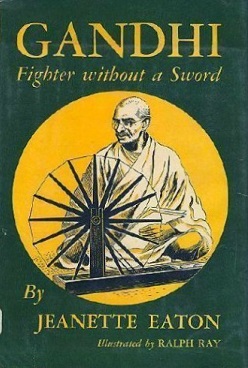Gandhi, Fighter Without a Sword facts for kids
Gandhi, Fighter Without a Sword is an exciting biography about Mohandas Karamchand Gandhi. It was written especially for young people by Jeanette Eaton and features illustrations by Ralph Ray. This book was first published in 1950 and was recognized as a Newbery Honor book in 1951, which is a big award for children's literature.
Contents
About the Book: Gandhi, Fighter Without a Sword
This book tells the amazing story of Mahatma Gandhi, a famous leader who used peaceful methods to fight for freedom and justice. It helps young readers understand his life and the important ideas he stood for.
What is a Biography?
A biography is a book that tells the true story of a real person's life. It covers their childhood, education, career, challenges, and achievements. Gandhi, Fighter Without a Sword is a biography because it shares the true events of Gandhi's life.
Why is it a Newbery Honor Book?
The Newbery Medal is one of the most respected awards for children's books in the United States. A "Newbery Honor" means the book was one of the top runners-up for the main award. This shows that Gandhi, Fighter Without a Sword is considered a very well-written and important book for young readers.
The Author: Jeanette Eaton
Jeanette Eaton (1886–1968) was an American author known for writing biographies for children and young adults. She had a talent for making history and important figures come alive for her readers. Besides the book about Gandhi, she wrote other biographies about historical figures like George Washington and Abraham Lincoln. Her goal was to inspire young people by sharing stories of courage and leadership.
The Illustrator: Ralph Ray
Ralph Ray was the artist who created the pictures for Gandhi, Fighter Without a Sword. Illustrations are very important in children's books because they help readers imagine the characters and events described in the story. Ray's drawings helped bring Gandhi's world to life for young readers.
Who Was Mahatma Gandhi?
Mohandas Karamchand Gandhi (1869–1948) is one of the most famous leaders in world history. He is often called Mahatma, which means "Great Soul" or "Revered One." He was a lawyer, anti-colonial nationalist, and civil rights activist who became the leader of the Indian independence movement against British rule.
Gandhi's Early Life and Education
Gandhi was born in Porbandar, India. His father was a government official, and his mother was a very religious woman. He grew up learning about different faiths and the importance of peace. As a young man, he traveled to London, England, to study law. After becoming a lawyer, he went to South Africa, where he worked for many years.
Fighting for Justice in South Africa
In South Africa, Gandhi experienced and saw a lot of unfair treatment and discrimination against Indian people. This made him decide to fight for their rights. He developed a unique way of protesting called Satyagraha, which means "truth-force" or "soul-force." It was all about non-violent resistance. Instead of fighting with weapons, he encouraged people to protest peacefully, even if it meant going to jail or facing hardship.
Leading India to Freedom
When Gandhi returned to India in 1915, he became a leader in the movement for India's independence from British rule. He believed that India should be free and that this freedom could be achieved through non-violence. He organized many peaceful protests, marches, and boycotts.
Famous Non-Violent Actions
- The Salt March (1930): One of Gandhi's most famous actions was the Salt March. The British government had a law that made it illegal for Indians to collect or sell salt, forcing them to buy expensive British salt. Gandhi led thousands of people on a 240-mile walk to the sea to make their own salt. This act of peaceful defiance showed the world the injustice of British rule.
- Non-Cooperation Movement: Gandhi encouraged Indians to refuse to cooperate with British laws and institutions. This included boycotting British goods, refusing to work for the British government, and not attending British schools.
Gandhi's Legacy
Through his dedication to non-violence and truth, Gandhi helped India gain its independence in 1947. He showed the world that powerful change can happen without violence. His ideas have inspired many other civil rights leaders around the globe, including Martin Luther King Jr. in the United States and Nelson Mandela in South Africa. He is remembered as a symbol of peace, justice, and freedom.
Why Read Gandhi, Fighter Without a Sword?
This book is a great way for young readers to learn about a truly inspiring person. It teaches about:
- The power of peaceful protest and non-violence.
- The importance of fighting for what is right.
- How one person can make a huge difference in the world.
- The history of India's struggle for independence.
It's a story about courage, determination, and the belief that even without a sword, you can be a powerful fighter for good.


